Tedocad 20 Mg/0.5 Ml Concentrate And Solvent For Solution For Infusion
Package leaflet: Information for the user
Tedocad 20 mg/0.5 ml concentrate and solvent for solution for infusion Tedocad 80 mg/2 ml concentrate and solvent for solution for infusion
Docetaxel
Read all of this leaflet carefully before you start using this medicine because it contains important
information for you.
- Keep this leaflet. You may need to read it again.
- If you have any further questions, ask your doctor or pharmacist or nurse.
- This medicine has been prescribed for you only. Do not pass it on to others. It may harm them, even if their signs of illness are the same as yours.
- If you get any side effects, talk to your doctor or pharmacist or nurse. This includes any possible side effects not listed in this leaflet. See section 4.
- The full name of the medicinal product is Tedocad 20 mg/0.5 ml concentrate and solvent for solution for infusion and Tedocad 80 mg/2 ml concentrate and solvent for solution for infusion, but within the leaflet it will be referred to as Tedocad.
What is in this leaflet
1. What Tedocad is and what it is used for
2. What you need to know before you use Tedocad
3. How to use Tedocad
4. Possible side effects
5. How to store Tedocad
6. Contents of the pack and other information
1. What Tedocad is and what it is used for
The name of this medicine is Tedocad. Its common name is docetaxel. Docetaxel is a substance derived from the needles of yew trees.
Docetaxel belongs to the group of anti-cancer medicines called taxoids.
Tedocad has been prescribed by your doctor for the treatment of breast cancer, special forms of lung cancer (non-small cell lung cancer), prostate cancer, gastric cancer or head and neck cancer:
- For the treatment of advanced breast cancer, Tedocad could be administered either alone or in combination with doxorubicin, or trastuzumab, or capecitabine.
- For the treatment of early breast cancer with lymph node involvement, Tedocad could be administered in combination with doxorubicin and cyclophosphamide.
- For the treatment of lung cancer, Tedocad could be administered either alone or in combination with cisplatin.
- For the treatment of prostate cancer, Tedocad is administered in combination with prednisone or prednisolone.
- For the treatment of metastatic gastric cancer, Tedocad is administered in combination with cisplatin and 5-fluorouracil.
- For the treatment of head and neck cancer, Tedocad is administered in combination with cisplatin and 5-fluorouracil.
2. What you need to know before you use Tedocad You must not be given Tedocad if
• you are allergic to docetaxel or any other ingredients of this mediine (listed in section 6).
• the number of white blood cells is too low.
• you have a severe liver disease.
Warnings and precautions
Talk to your doctor or pharmacist or nurse before using Tedocad
Before each treatment with Tedocad, you will have blood tests to check that you have enough blood cells and sufficient liver function to receive Tedocad. In case of white blood cells disturbances, you may experience associated fever or infections.
Tell your doctor, hospital pharmacist or nurse if you have vision problems. In case of vision problems, in particular blurred vision, you should immediately have your eyes and vision examined.
If you develop acute or worsening problems with your lungs (fever, shortness of breath or cough), please tell your doctor, hospital pharmacist or nurse immediately. Your doctor may stop your treatment immediately.
You will be asked to take premedication consisting of an oral corticosteroid such as dexamethasone, one day prior to Tedocad administration and to continue for one or two days after it in order to minimise certain undesirable effects which may occur after the infusion of Tedocad in particular allergic reactions and fluid retention (swelling of the hands, feet, legs or weight gain).
During treatment, you may be given medication to maintain the number of your blood cells.
Tedocad contains alcohol. Discuss with your doctor if you suffer from alcohol dependency, epilepsy or liver impairment. See also section “Tedocad contains ethanol (alcohol)” below.
Other medicines and Tedocad
Tell your doctor or hospital pharmacist if you are taking or have recently taken any other medicine, including medicines obtained without a prescription. This is because Tedocad or the other medicine may not work as well as expected and you may be more likely to get a side effect.
The amount of alcohol in this medicinal product may alter the effects of other medicines.
Pregnancy, breast-feeding and fertility
Ask your doctor for advice before being given any medicine.
Tedocad must NOT be administered if you are pregnant unless clearly indicated by your doctor.
You must not become pregnant during treatment with this medicine and must use an effective method of contraception during therapy, because Tedocad may be harmful for the unborn baby. If pregnancy occurs during your treatment, you must immediately inform your doctor.
You must NOT breast-feed while you are treated with Tedocad.
If you are a man being treated with Tedocad you are advised not to father a child during and up to 6 months after treatment and to seek advice on conservation of sperm prior to treatment because docetaxel may alter male fertility.
Driving and using machines
No studies on the effects on the ability to drive and use machines have been performed.
Tedocad contains ethanol (alcohol)
This medicinal product contains 9.53% (w/w) ethanol absolute 95%v/v (alcohol), i.e. up to 50 mg ethanol 95% v/v per solvent vial, equivalent to 1.2 ml of beer or 0.5 ml wine per vial.
This medicinal product contains 9.53% (w/w) ethanol absolute 95% v/v (alcohol), i.e up to 200mg ethanol 95% v/v per solvent vial, equivalent to 5 ml of beer or 2 ml wine per vial.
Harmful for those suffering from alcoholism.
To be taken into account if you are pregnant or if you are breast-feeding women, in children and in high-risk groups such as patients with liver disease or epilepsy.
The amount of alcohol in this medicinal product may have effects on the central nervous system (the part of the nervous system that includes the brain and spinal cord).
The amount of alcohol in this medicinal product may alter the effects of other medicines.
The amount of alcohol in this medicine may impair your ability to drive or use machines.
3. How to use Tedocad
Tedocad will be administered to you by a healthcare professional.
Usual dosage
The recommended dose will depend on your weight and your general condition. Your doctor will calculate your body surface area in square meters (m2) and will determine the dose you should receive.
Method and route of administration
Tedocad will be given by infusion into one of your veins intravenous). The infusion will last approximately one hour during which you will be in the hospital.
Frequency of administration
You should usually receive your infusion once every 3 weeks.
Your doctor may change the dose and frequency of dosing depending on your blood tests, your general condition and your response to Tedocad. In particular, please inform your doctor in case of diarrhoea, sores in the mouth, feeling of numbness or pins and needles, fever and give her/him results of your blood tests. Such information will allow her/him to decide whether a dose reduction is needed. If you have any further questions on the use of this product, ask your doctor, or hospital pharmacist.
If you have any further questions on the use of this medicine, ask your doctor, pharmacist or nurse.
4. Possible side effects
Like all medicines, this medicine can cause side effects, although not everybody gets them.
Your doctor will discuss these with you and will explain the potential risks and benefits of your treatment.
The most commonly reported adverse reactions of Tedocad alone are: decrease in the number of red blood cells or white blood cells, alopecia, nausea, vomiting, sores in the mouth, diarrhea and tiredness.
The severity of adverse events of Tedocad may be increased when Tedocad is given in combination with other chemotherapeutic agents.
During the infusion at the hospital the following allergic reactions (may affect more than 1 in 10 people)::
• flushing, skin reactions, itching,
• chest tightness; difficulty in breathing,
• fever or chills,
• back pain
• low blood pressure
More severe reactions may occur.
The hospital staff will monitor your condition closely during treatment. Tell them immediately if you notice any of these effects.
Between infusions of Tedocad the following may occur, and the frequency may vary with the combinations of drugs that are received:
Very Common: may affect more than 1 in 10 people
• infections, decrease in the number of red (anaemia), or white blood cells (which are important in fighting infection) and platelets,
• fever: if this happens you must tell your doctor immediately
• allergic reactions as described above
• loss of appetite (anorexia)
• insomnia
• feeling of numbness or pins and needles or pain in the joints of muscles
• headache
• alteration in sense of taste
• inflammation of the eye or increased tearing of the eyes
• swelling caused by faulty lymphatic drainage
• shortness of breath
• nasal drainage; inflammation of the throat and nose; cough
• bleeding from the nose
• sores in the mouth
• stomach upsets including nausea, vomiting and diarrhea, constipation
• abdominal pain
• indigestion
• hair loss (in most cases normal hair growth should return)
• redness and swelling of the palms of your hands or soles of your feet which may cause your skin to peel (this may also occur on the arms, face, or body)
• change in the color of your nails, which may detach
• muscle aches and pains; back pain or bone pain
• change or absence of menstrual period
• swelling of the hands, feet, legs
• tiredness; or flu-like symptoms
• weight gain or loss
Common: may affect up to 1 in 10 people
• oral candidiasis
• dehydration
• dizziness
• hearing impaired
• decrease in blood pressure; irregular or rapid heart beat
• heart failure
• oesophagitis
• dry mouth
• difficulty or painful swallowing
• haemorrhage
• raised liver enzymes (hence the need for regular blood tests)
Uncommon: may affect up to 1 in 100 people
• fainting
• at the injection site, skin reactions, phlebitis (inflammation of the vein) or swelling
• inflammation of the colon, small intestine; intestinal perforation
• blood clots
Frequency unknown:
• interstitial lung disease (inflammation of the lungs causing coughing and difficulty breathing.
Inflammation of the lungs can also develop when docetaxel therapy is used with radiotherapy)
• pneumonia (infection of the lungs)
• pulmonary fibrosis (scarring and thickening in the lungs with shortness of breath)
• blurred vision due to swelling of the retina within the eye (cystoid macular oedema)
• decrease of the sodium in your blood.
Reporting of side effects
If you get any side effects, talk to your doctor or pharmacist or nurse. This includes any possible side effects not listed in this leaflet. You can also report side effects directly via the Yellow Card Scheme at: www.mhra.gov.uk/yellowcard. By reporting side effects you can help provide more information on the safety of this medicine.
5. How to store Tedocad
Keep this medicine out of the sight and reach of children.
Do not use this medicine after the expiry date which is stated on the outer carton, blister pack and on the label of vial after EXP. The expiry date refers to the last day of that month.
Do not store above 25° C.
Store in the original package in order to protect from light.
The premix solution should be used immediately after preparation. However the chemical and physical stability of the premix solution has been demonstrated for 8 hours when stored either between 2° C and 8° C or at room temperature (below 25° C).
The infusion solution should be used within 4 hours at room temperature (below 25° C).
Do not throw away any medicines via wastewater or household waste. Ask your pharmacist how to throw away medicines you no longer use. These measures will help protect the environment.
6. Contents of the pack and other information What Tedocad contains
- The active substance is docetaxel. Each ml of docetaxel solution contains 40 mg of docetaxel anhydrous. One vial contains 20 mg/0.5 ml or 80 mg/2 ml of docetaxel.
- The other ingredients are citric acid anhydrous, ethanol absolute and polysorbate 80.
The solvent vial contains 9.53% w/w ethanol absolute in water for injections.
What solvent vial contains
9.53% (w/w) ethanol absolute (see section 2) in water for injections
What Tedocad looks like and contents of the pack:
Tedocad concentrate for solution for infusion is a clear, oily, yellow solution.
The solvent is a clear, colourless solution.
Each blister pack contains Tedocad 20 mg/0.5 ml
• one single dose vial of concentrate and,
• one single dose vial of solvent
Tedocad 80 mg/2 ml
• one single dose vial of concentrate and,
• one single dose vial of solvent
Marketing Authorisation Holder and Manufacturer
Marketing Authorisation Holder
Aptil Pharma Limited Unit 4, Charlwood Court,
County Oak Way,
Crawley, West Sussex,
RH11 7XA United Kingdom
Manufacturer
S.C. SINDAN-PHARMA S.R.L.
11th Ion Mihalache Blvd, 011171
Bucharest
Romania
This leaflet was last revised in 06/2016.
The following information is intended for medical or healthcare professionals only:
PREPARATION GUIDE FOR USE WITH TEDOCAD CONCENTRATE FOR SOLUTION FOR INFUSION AND SOLVENT
It is important to read the entire contents of this procedure prior to the preparation of either the Tedocad premix solution or the Tedocad infusion solution
1. FORMULATION
Tedocad 20 mg/0.5 ml
Each blister pack contains:
• one single dose Tedocad vial of concentrate 20 mg/0.5 ml
• one single dose solvent for Tedocad vial of concentrate 1.5 ml
Tedocad 80 mg/2 ml
Each blister pack contains:
• one single dose Tedocad vial of concentrate 80 mg/2 ml • one single dose solvent for Tedocad vial of concentrate 6 ml
2. PRESENTATION
2.1 Tedocad 20 mg/0.5 ml vial
Tedocad 20 mg/0.5 ml concentrate for solution for infusion vial 8 ml clear glass Type I vial with a flip-off cap.
This vial contains 0.5 ml of a 40 mg/ml solution of docetaxel in citric acid anhydrous, polysorbate 80 and ethanol absolute (fill volume: 25.2mg/0.63 ml). This fill volume has been established during the development of Tedocad to compensate for liquid loss during preparation of the premix due to foaming, adhesion to the walls of the vial and "dead-volume". This overfill ensures that after dilution with the entire contents of the accompanying solvent for Tedocad vial, there is a minimal extractable premix volume of 2 ml containing 10 mg/ml docetaxel which corresponds to the labelled amount of 20 mg/0.5 ml per vial.
2.2 Solvent for Tedocad 20 mg/0.5 ml vial
Solvent vial: 8 ml clear glass Type I vial with a flip-off cap.
Solvent vial contains 1.5 ml of a 9.53% w/w solution of ethanol absolute in water for injections (fill volume:
2.0 ml). The addition of the entire contents of the solvent vial to the contents of the Tedocad 20 mg/0.5 ml concentrate for solution for infusion vial ensures a premix concentration of 10 mg/ml docetaxel.
2.1 Tedocad 80 mg/2 ml vial
Tedocad 80 mg/2 ml concentrate for solution for infusion vial:
15 ml clear glass Type I vial with a flip-off cap.
This vial contains 2 ml of a 40 mg/ml solution of docetaxel in citric acid anhydrous, polysorbate 80 and ethanol absolute (fill volume: 92.0 mg/2.3 ml). This fill volume has been established during the development of Tedocad to compensate for liquid loss during preparation of the premix due to foaming, adhesion to the walls of the vial and "dead-volume". This overfill ensures that after dilution with the entire contents of the accompanying solvent for Tedocad vial, there is a minimal extractable premix volume of 8 ml containing 10 mg/ml docetaxel which corresponds to the labelled amount of 80 mg/2 ml per vial.
2.2 Solvent for Tedocad 80 mg/ 2 ml vial
Solvent vial: 15 ml clear glass Type I vial with a flip-off cap.
Solvent vial contains 6 ml of a 9.53% w/w solution of ethanol absolute in water for injections (fill volume:
7.04 ml). The addition of the entire contents of the solvent vial to the contents of the Tedocad 80 mg/2 ml concentrate for solution for infusion vial ensures a premix concentration of 10 mg/ml docetaxel.
3. RECOMMENDATIONS FOR THE SAFE HANDLING
Tedocad is an antineoplastic agent and, as with other potentially toxic compounds, caution should be exercised when handling it and preparing Tedocad solutions. The use of gloves is recommended. If Tedocad concentrate, premix solution or infusion solution should come into contact with skin, wash immediately and thoroughly with soap and water. If Tedocad concentrate, premix solution or infusion solution should come into contact with mucous membranes, wash immediately and thoroughly with water.
4. PREPARATION FOR THE INTRAVENOUS ADMINISTRATION
4.1 Preparation of the Tedocad premix solution (10 mg docetaxel/ml)
4.1.1. If the vials are stored under refrigeration, allow the required number of Tedocad boxes to stand at room temperature for 5 minutes.
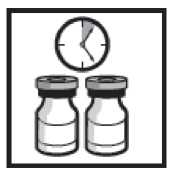
4.1.2. Using a syringe fitted with a needle, aseptically withdraw the entire contents of the solvent for Tedocad vial by partially inverting the vial.
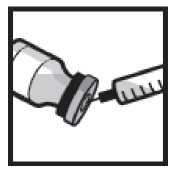
4.1.3. Inject the entire contents of the syringe into the corresponding Tedocad vial.
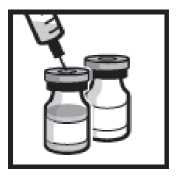
4.1.4. Remove the syringe and needle and mix manually by repeated inversions for at least 120 seconds. Do not shake.
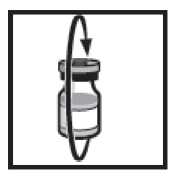
4.1.5. Allow the premix vial to stand for 3 minutes at room temperature and then check that the solution is homogenous and clear (foaming is normal even after 3 minutes due to the presence of polysorbate 80 in the formulation).
The premix solution contains 10 mg/ml docetaxel and should be used immediately after preparation. However the chemical and physical stability of the premix solution has been demonstrated for 8 hours when stored either between 2°C and 8°C or at room temperature (below 25°C).
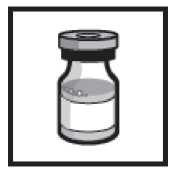
4.2 Preparation of the infusion solution
4.2.1. More than one premix vial may be necessary to obtain the required dose for the patient. Based on the required dose for the patient expressed in mg, aseptically withdraw the corresponding premix volume containing 10 mg/ml docetaxel from the appropriate number of premix vials using graduated syringes fitted with a needle. For example, a dose of 140 mg docetaxel would require 14 ml docetaxel premix solution.
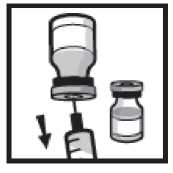
4.2.2. Inject the required premix volume into a 250 ml infusion bag or bottle containing either 5% glucose solution or 0.9% sodium chloride solution.
If a dose greater than 200 mg of docetaxel is required, use a larger volume of the infusion vehicle so that a concentration of 0.74 mg/ml docetaxel is not exceeded.

4.2.3. Mix the infusion bag or bottle manually using a rocking motion.
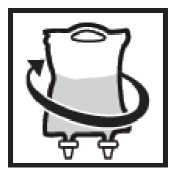
4.2.4 The Tedocad infusion solution should be used within 4 hours and should be aseptically administered as a 1-hour infusion under room temperature and normal lighting conditions.
4.2.5 As with all parenteral products, Tedocad premix solution and infusion solution should be visually inspected prior to use, solutions containing a precipitate should be discarded.
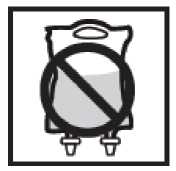
5. SHELF LIFE
• Premix solution: The premix solution contains 10 mg/ml docetaxel and should be used immediately after preparation. However the chemical and physical stability of the premix solution has been demonstrated for 8 hours when stored either between 2°C and 8°C or at room temperature (below 25°C). The premix solution is for single use only.
• Infusion solution: Chemical and physical in-use stability has been demonstrated for 4 hours at about 25°C at normal lighting conditions, and 4 hours at 5°C ± 3°C protected from light. From a microbiological point of view, the product should be used immediately. If not used immediately, in-use storage times and conditions prior to use are the responsibility of the user and would normally not be longer than 24 hours at 2 to 8°C, unless dilution has taken place in controlled and validated aseptic conditions.
6. DISPOSAL
Any unused product or waste material should be disposed of in accordance with local requirements.
10